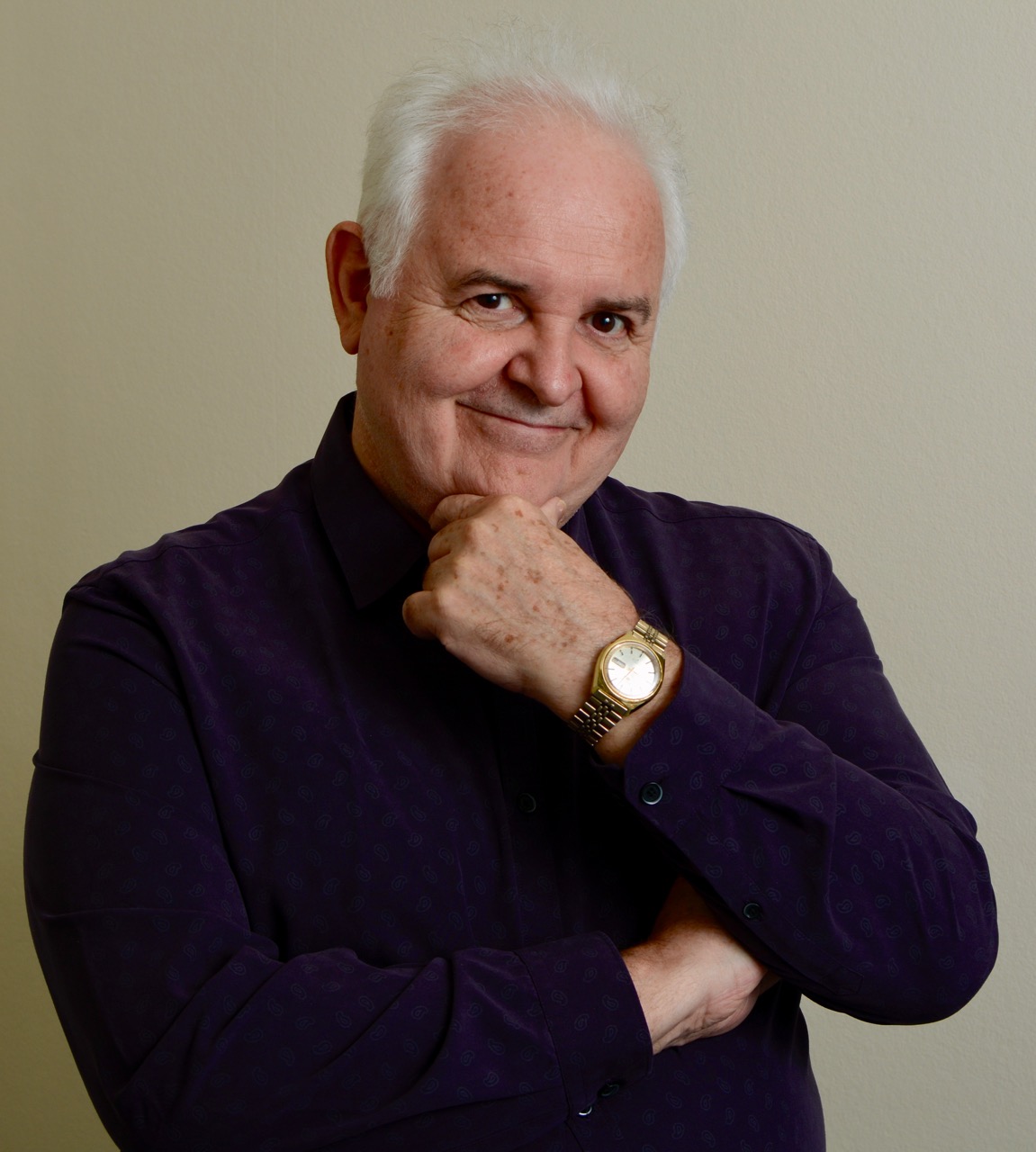Uploading my games to a database for the first time has made my chess life flash before my squinting eyes. And it has not been a pretty sight
John Foley
I recently embarked on the task of uploading my games to a database for the first time. This has engendered the strange feeling of my life passing before my eyes as I scroll through the games. This life review experience is sometimes reported by people when they are falling from a height to their presumed death. One theory is that this is due to “cortical inhibition” – a breaking down of the normal regulatory processes of the brain – in highly stressful or dangerous situations, causing a “cascade” of mental impressions. Looking through my past games is stressful, indeed traumatic. I am recalling matters long since deliberately buried in the recesses of my memory. Twinges of regret are surfacing to remind me of my cognitive limitations (or, if I am being cruel to myself, stupidity).
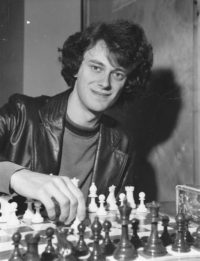
This late-chess-life crisis all started after I had given John Nunn a lift to Ashtead for the Alexander Cup final, the Surrey team knockout championship, in 2018. In the pre-digital age, we had met in the London Under-14 championship and inevitably I had lost, but I couldn’t remember anything about the game. I went on to win the London Under-16 (ahead of a certain Jonathan Speelman) whereas at the same time John Nunn won the London Under-18. Given his prodigious talent, he won everything as a junior in England and had set his sights abroad. By the time I won the Oxford University Chess Club (OUCC) championship in 1976, he had a doctorate in mathematics and was well on his way to becoming a grandmaster.
As we wended our way back through the Surrey Hills, I nonchalantly mentioned that he was the reason I had given up chess. He seemed abashed at my unwonted revelation. I explained that it was apparent some people were so talented that there was no point in competing with them. On the principle of comparative advantage, I should spend my time doing something else. However, I was foolish; I had misinterpreted the data by observing only those around me – the “availability bias”. I had not twigged that I was amongst a special generation – two of my university contemporaries, John Nunn and Jonathan Speelman, were the core members of the England team that went on to win the silver medal at the Chess olympiads in 1984, 1986 and 1988, behind the mighty Soviet Union. I mentally placed chess in a box called “it was fun while it lasted” and embarked on a modelling career (not that sort of modelling!).
The Yugoslav Attack after 10.h4
Soon after our trip, John sent me the game we had played in the Under-14 championship in which I had succumbed to his Yugoslav Attack. I winced as I recalled my temerity in playing the Sicilian Dragon without having even read a book on it (although to be fair maybe one had not yet been written in English). The game is too embarrassing to show, at least if I am to retain any sense of dignity. What struck me was that Doccy (as Nunn is universally known in the chess community) had recorded, studied and still remembered every opponent and probably every game he had ever played. You don’t get into the top 10 players in the world by being casual; you need focused application.
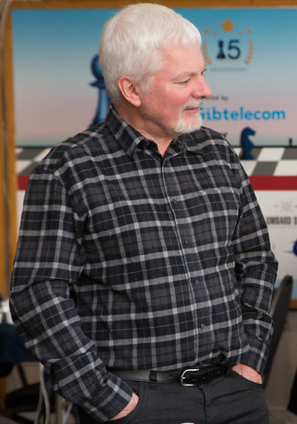
I recall a conversation with Mike Truran, progenitor of the 4NCL, the national chess league, just prior to his being ensconced as chief executive of the English Chess Federation (ECF). Over an entertaining lunch at the Fleece, his favourite hostelry in Witney, he casually mentioned that we had played in the university championships. “Oh really”, I enquired, “what happened?” He had won, he beamed. I could not recall the game, let alone the result. Nor could I remember my opponent, but I was too polite to mention this – he probably wasn’t as handsome then as he is now with a trimmed goatee. It turned out that Mike had also kept a careful record of all his encounters over the board. By contrast, in those days I had seen myself as being on the grand tour of intellectual self-discovery – and, dare I admit, romance – whilst occasionally conceding to the seductive charm of chess.

It is only in hindsight that one can make sense of disconnected comments. When I resumed chess after 25 years in the “real” world, I was playing in an evening league match next to Robin Haldane, the terrific and prolific suburban competitor, who informed me that I had beaten him in a “very nice game” in the London Under-14. This was the final proof that I was in the minority of players who treated the game without the respect it deserved. I should have been keeping a record of each game. Only thus would I be able to respond to Robin with some informed pleasantry such as “but you put up a stout defence”.
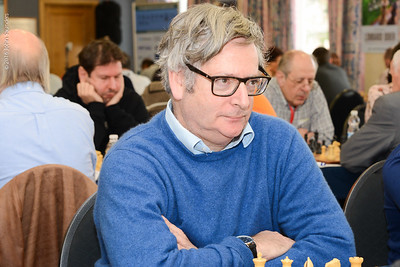
Yet I should have been forearmed. In the OUCC championships of 1975, I played Dominic Lawson, now a distinguished journalist and the esteemed president of the ECF. Dominic played a crisp, albeit obvious, combination to win. He was surprised to discover later that the combination had been included in a compilation book (presumably for beginners). As he recounted to ChessBase in 2014, and previously in Chess magazine in the 1980s, he was pleased by this recognition and cited it as his most memorable game.
White to play and win
Dominic Lawson v John Foley (Oxford University Championship, 1975)
Although not thrilled to be on the receiving end of a published combination, I drew some comfort from the dictum that it takes two players to make a game. It is only worth publishing moves in games where there is some reasonable opposition. I noted that my repertoire had moved on from the Sicilian to the French Defence, but I could still be crushed in both. My regret in reading Dominic’s article was not that I had lost to a cheapo (the move, not him), but that I could not lay my hands on the game in which I beat him the following year on my way to the championship title. I recall I played the Modern Benoni with the f5 flourish, as made famous by Jonathan Penrose, who beat the then world champion Mikhail Tal in the Leipzig Olympiad in 1960. If only I had had that game, I could have fashioned some riposte. Actually, I have not quite abandoned the last thread of hope, because there are still some storage boxes in the attic which have not been disinterred in decades.
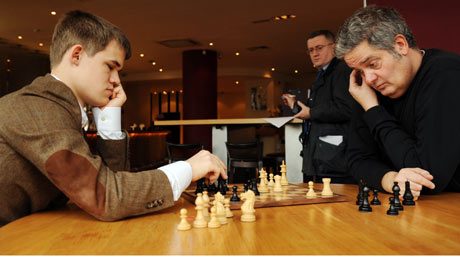
I fancied that a future biographer would write an encomium about how an average club player could, after years of apathy, apply himself intensively and become a grandmaster. This was more or less the theme of The Rookie, the book written by my Kingston colleague, and another contemporary at the OUCC, the Guardian writer Stephen Moss, which tracks his odyssey through chess (and life).
Yet subconsciously I had evolved almost the same attitude as Ken Inwood, one of Kingston’s strongest players for decades. Ken discards his scoresheet after each game in what appears to be a careless disregard for self-improvement. But then Ken does not have anything to prove, having won the London Under-14 and Under-18 titles before becoming the British Boys’ Champion at Hastings in 1953 and playing top board for England in the Glorney Cup. He has for many decades made a pilgrimage to the Hastings international tournament at the turn of each year to watch the top games with flask at the ready. There comes a stage when chess is played for pure enjoyment, win or lose.
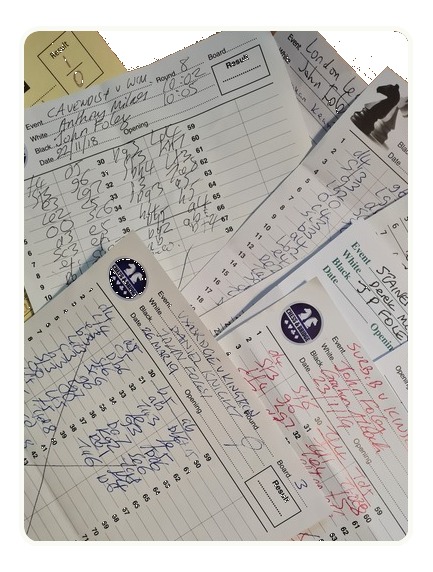
At least I had the foresight to hang on to these precious documents. Wads of distressed scoresheets have been strewn in drawers and stuffed into bookshelves. The process has begun of collating and painstakingly transcribing the moves of the games I can unearth into Hiarcs, the Mac-friendly chess database and engine. Some of my games were conveniently retrieved from doubly checked online databases such as 4NCL’s. That made me realise what a terrible written record I had kept of the moves.
Note on notation: the algebraic system gives rise to reflection errors when recording: a becomes h and b becomes g; 1 becomes 8 and 2 becomes 7 etc, so there is a lot of decoding required. One must play a game out until the moves no longer make sense and then reverse back to the last reflection. Descriptive notation largely precludes this sort of error.
The main defect of transcription, however, cannot be cured by any notation system. The problem occurs towards the end of each game. When time is short, accuracy goes out the window. Distinguishing between moves and squiggles becomes impossible. In the worst case, when the remaining time drops below five minutes, it is no longer mandatory to record the moves. The end of the game is lost to history unless the opponent is obliging. Returning to a game years later, one plays through to a perfectly good position up to move 35 or so, but then the scoresheet puzzlingly records the game as a loss.
The advice for constructing personal game histories, learned late in my life, is to correct the scoresheet immediately after the game. Ideally, one should make some quick notes on the game – perhaps during the post-mortem analysis conducted by the players – and input the moves without delay.
The games I am currently inputting are from random dates in the past. I am up to game 150, which must be a tiny fraction of the games played in my chess “career”. The games are not of any theoretical importance, except that each game can trigger a personal memory or give rise to a newly perceived finesse with potential instructive value. A game fitting this latter category was one I played as Black against Martin Gruau in a Surrey v Kent county match in 2018. After a hard-fought and complex game, we reached the following position. I was so sure I was winning, and the move so obvious, that I did not think I needed to calculate my next move.
Black to play and win
Martin Gruau v John Foley. Surrey v Kent, 27 January 2018
Like anybody else who has been striving for victory for five hours at the board in a chilly community hall, I was exhausted, but finally the win was within my grasp. In the diagram, Black is playing down the board. My king had advanced and pushed my opponent’s king to the back rank. I could capture the a3 pawn and then saunter over to pick up the h6 pawn, whilst the white king had to deal with the passed a4 pawn. I should be able to shoulder off the white king if it tried to race over to stop the h pawn. This much was clear and there was no need to consider any other plan. So I played 70 … Kxa3? There followed 71 Ka1! I followed my ill-thought plan and we reached this position after Black’s 75th move.
White to play and draw
I was on track but my opponent seemed confident, which was rather worrying- wasn’t he supposed to resign? I finally began to put my brain in gear and realised that I had sleepwalked into a draw. The final position is shown below. The black king is forced to the edge and cannot escape without allowing the white king to reach the drawing square h8. Dagnabbit! I dealt with the anguish by the technique of instant forgetfulness – the nostrum of choice for the disappointed player.
Drawn
So as I was inputting and reviewing the game again, I noticed something surprising. I had been right to believe that I had a winning move in the opening diagram position. The finesse is to refrain from capturing the a3 pawn! I had played a pedestrian move, failing to recognise that I was standing at a crossroads. During a game one is not presented with a caption “white to play and win” which would immediately raise the level of awareness.
The crucial point is that if Black captures the a3 pawn, then the white king is given a shortcut to Black’s a4 pawn via a2 in two moves instead of the long way round via c3 and b4 in three moves. In an endgame, a tempo can make all the difference. White gains a move to advance and promote the h pawn. Black should have been counting tempi rather than material. In fact, in the diagram, remove the a3 pawn and white still draws a pawn down. A common error and one which the diligent student of the game should have been able to figure out. There may be many more such gems yet to be recovered from the past.
Reverting to the classic lunch at the Fleece (or should that be the Golden Fleece), Mike Truran, who studied languages at Oxford, vouchsafed to me a line from the Aeneid: forsan et haec olim meminisse iuvabit. Classical scholars still debate the precise translation, but one interpretation is: “Someday, perhaps, it will help to remember those troubles as well.” The positive take on this aphorism is that, far from forgetting unpleasant experiences, we should instead wait and integrate them into our personal experience when we are ready. There will come a point when we confront adversity and feel more complete for doing so. The more I review my historical games collection, the more I understand the narrative of my life.
Photo credits: Sophie Triay (Mike Truran); Linda Nylind (Stephen Moss); Brendan O’Gorman (Robin Haldane)

